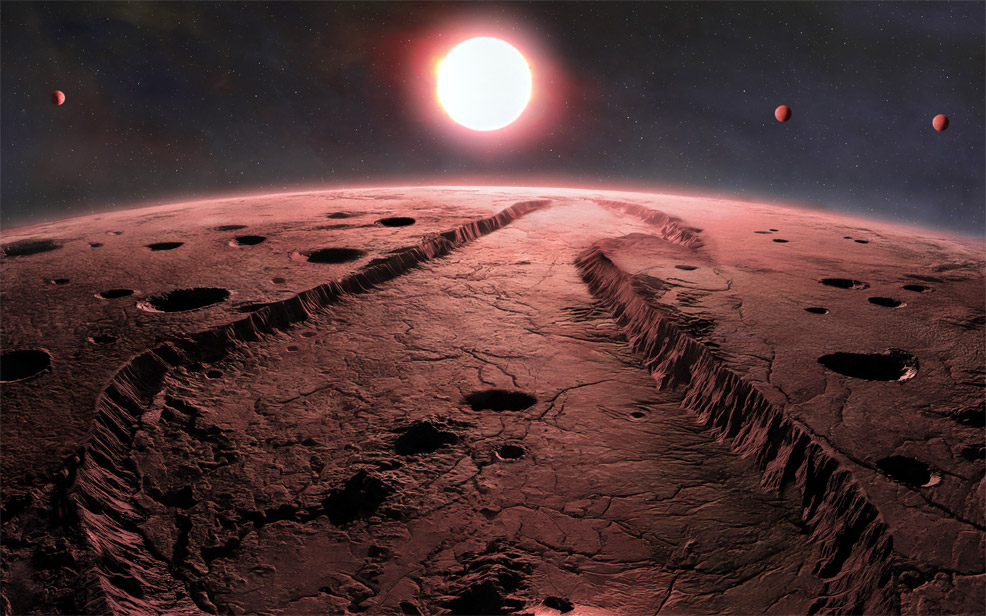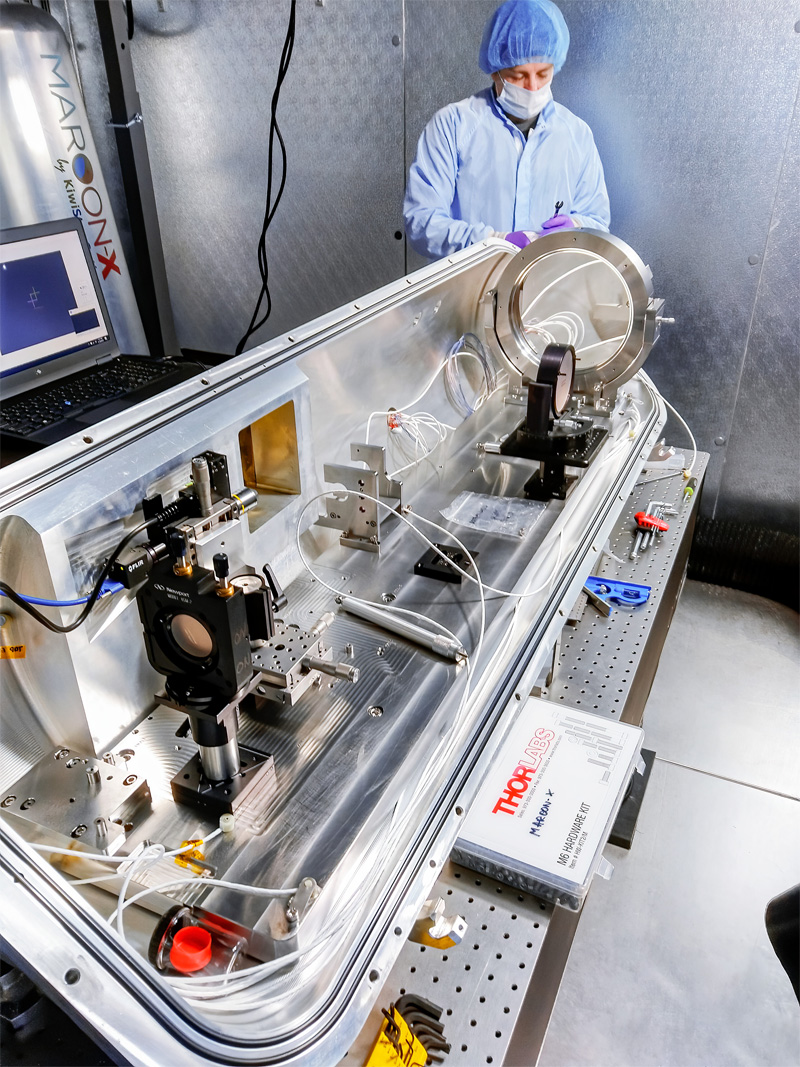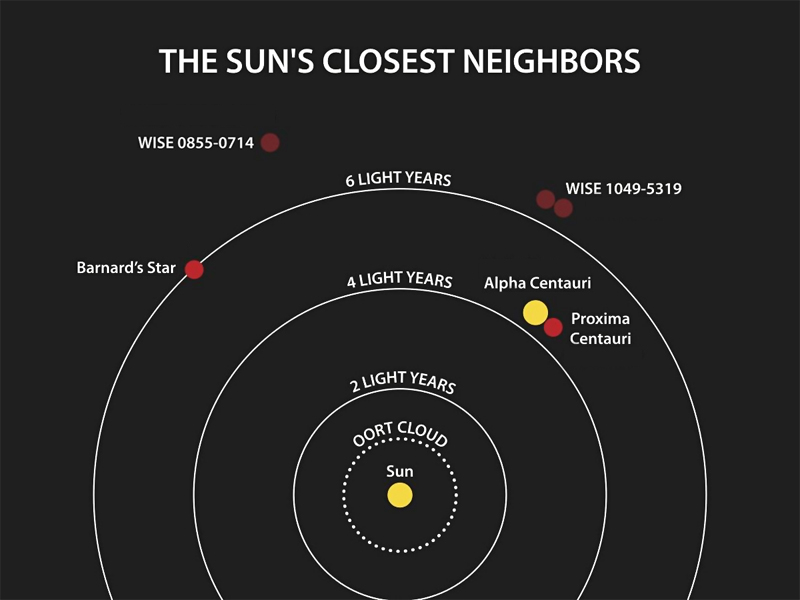
18th March 2025 Four small exoplanets confirmed around Sun's neighbour Three new rocky exoplanets – all smaller than Earth – have been detected around Barnard's Star, the closest solitary star to our own Sun at just 5.96 light-years away. Barnard b, a candidate world that observations had revealed previously, is also confirmed, bringing the total number of known planets around the star to four.
Using the Gemini North telescope in Hawaii, astronomers from the National Science Foundation's NOIRLab have discovered four sub-Earth exoplanets orbiting Barnard's Star, the nearest single star system to Earth. One of the new planets, designated as Barnard e, is the least massive exoplanet ever discovered using the radial velocity technique, setting a new benchmark for discovering smaller planets around nearby stars. Astronomers have been studying Barnard's Star for over a century in the hope of finding planets around it. First discovered by Edward Barnard in 1916, it is the nearest single star system to Earth, at less than six light-years distance (Alpha Centauri, although closer, is a triple-star system). Barnard's Star is classified as a red dwarf – cool and low-mass stars, often hosting closely-packed systems with multiple rocky planets. Red dwarfs are by far the most numerous star type in the Universe, so scientists are interested in understanding the environments of the planets they host. A team led by Jacob Bean from the University of Chicago created a new instrument called MAROON-X, which is designed specifically to search for distant planets around red dwarfs. MAROON-X is mounted on the Gemini North telescope, one half of the International Gemini Observatory, funded in part by the U.S. National Science Foundation and operated by NOIRLab.
MAROON-X, pictured above, stands for M-dwarf Advanced Radial velocity Observer Of Neighboring eXoplanets. The instrument is designed to sense exoplanets using the radial velocity technique, meaning it detects the subtle back and forth wobble of a star as its exoplanets gravitationally tug on it, which causes light emitted by the star to shift ever so slightly in wavelength. It measures these small shifts in light so precisely that it can even tease apart the number and masses of planets that must be circling the star to have the observed effect. After rigorously calibrating and analysing data taken during 112 nights over a period of three years, the team found solid evidence for three new exoplanets around Barnard's Star. They also combined their data with results from a 2024 study using the European Southern Observatory's Very Large Telescope in Chile to confirm the existence of a fourth planet, elevating it from candidate to bona fide exoplanet. "It's a really exciting find – Barnard's Star is our cosmic neighbour, and yet we know so little about it," said Ritvik Basant, a PhD student at the University of Chicago and the first author of a paper in The Astrophysical Journal Letters. "It's signalling a breakthrough with the precision of these new instruments from previous generations."
The newly discovered planets are most likely to be rocky, rather than gas worlds. However, this will be difficult to pin down with certainty since, because of the angle we observe them from Earth, they do not cross in front of their star, which is the usual method for determining a planet's composition. But with information from similar planets around other stars, the team will be able to make better estimates of their makeup. The scientists were, however, able to rule out with a fair degree of certainty the existence of other exoplanets with masses comparable to Earth in Barnard Star's habitable zone – the region around a star that is just right to allow liquid water on a planet's surface. Barnard's Star has been called the "great white whale" for planet hunters. Several times over the past century, groups have announced evidence that suggested planets orbiting around it, only for them to be subsequently disproved. But these latest findings give a much larger degree of confidence than all previous results. "We observed at different times of night on different days. They're in Chile; we're in Hawaii. Our teams didn't coordinate with each other at all," explains Basant. "That gives us a lot of assurance that these aren't phantoms in the data." The four planets are so close to their home star that their orbital periods are incredibly short, ranging from only 2.3 to 6.7 days. The fourth and outermost is the least massive planet discovered to date using the radial velocity technique, at just 19% of Earth's mass. The others have Earth masses of 26–34%. MAROON-X had initially been a temporary instrument. But given its outstanding performance and popularity with the user community, researchers are now converting it to a permanent installation at Gemini North. "This result demonstrates the competitive, state-of-the-art capabilities that Gemini offers its user community," says Andreas Seifahrt, Associate Director of Development at Gemini, co-author of the paper, and part of the team who designed and built MAROON-X. "The observatory is in the middle of rejuvenating its instrumentation portfolio, and MAROON-X is part of the first wave of new instruments."
Comments »
If you enjoyed this article, please consider sharing it:
|
||||||









